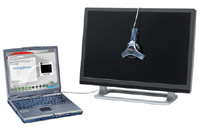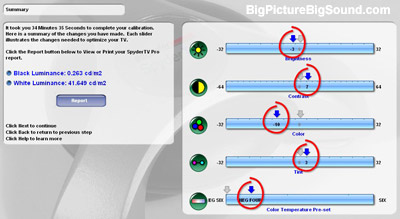How to Hook Up that Fancy New HDTV - Part III: Calibration
By Chris Boylan
What's Good for the Showroom is Not Good for the Living Room
Parts one and two of this series focused on demystifying the HDTV formats and resolution specs, and making the best connections between your new TV and existing gear. Now we'll turn to how you can tweak your HDTV to get the best possible picture from any source.
Most televisions, including flat panel HDTVs, come from the factory with default picture settings that make them "pop" on the showroom floor. This is so they will look brighter, clearer, sharper than the TV next to them. Take one of these televisions home and put it in the more subdued lighting of the living room or home theater and... well... it looks like utter crap!
This is not new. TV manufacturers have been doing this for a very long time. But what is new is that these new digital display technologies (plasma, LCD, DLP, LCOS, SXRD, etc.) look much worse when set up incorrectly than old analog CRT TVs ever did. What's a poor movie lover or sports fan to do? Calibrate it!
The best way to get the most out of your new flat panel TV is to hire an ISF (Imaging Science Foundation) professional to calibrate it to professional quality standards. Having been through ISF training myself (Thanks, Joel Silver!), I've experienced the rigors of their intensive color theory education, mixed with practical hands-on labs. Those who make it through the sessions and pass the ISF certification test know color and television technology cold. And these guys can get your new HDTV or projector looking the best it possibly can with eye-popping realism and natural colors. When necessary, they can even get into your TV's hidden service menus to adjust settings that you cannot (and would not want to) access.
ISF experts use a special measurement tool called a "colorimeter," made by a company such as Sencore. A colorimeter measures light output and color values precisely so that its operator can get your display as close as possible to the standards used by the television and movie studios - the people who actually create the movies and programs you watch. You'll find links to ISF professionals in your area on the ISF web site.

Professional HDTV calibration is typically done with specialized software and a light measurement tool called a colorimeter.
If you'd prefer to do this on your own, then you have a couple of choices: A.) do it by eye with the help of a home theater set-up or video calibration disc or B.) Get yourself a calibration tool similar to what the pros use, but for less money.
One consumer-friendly version of the television calibration tool used by professionals is called "SpyderTV." There is both the standard
SpyderTV (MSRP $250) and the more advanced
SpyderTV Pro version (MSRP $600). Both come with software, a test pattern DVD and a basic colorimeter.
The basic package works only with direct view CRT, LCD and Plasma televisions as well as RPTVs (rear projection televisions). It allows you to adjust color level, tint, brightness and contrast as well as selecting color temperature from a list of presets on your TV. The "Pro" version allows you to individually adjust red, green and blue gains (when offered in the television's set-up menus) for more precise control over color temperature. In addition to the TV types supported by the standard version, SpyderTV Pro also works with front projection systems.

SpyderTV's simple calibration software walks you through detailed picture adjustments and requires no advanced training or special knowledge of color theory.
Both SpyderTV packages require a computer (with USB connection) to run the calibration program and connect the colorimeter, plus a DVD player to play back the included test pattern DVD. It only takes 20 to 40 minutes to calibrate a TV from start to finish.
The lower cost DVD test disc option takes you through many of the same picture adjustments, but it relies on you using your own eyes (rather than the SpyderTV colorimeter) in order to make the appropriate settings. We recommend the Avia "Guide to Home Theater" disc as it includes straightforward instructions, excellent test patterns, color filters for tint and color adjustments, plus a battery of audio calibration tests as well. Either the calibration software or calibration by eye approach will allow you to make huge improvements in the picture quality of your new television.
Now Sit Back, Relax and Soak Up All That HDTV Goodness!
Sure, TV technology is more complicated today than it has ever been. And it may seem that buying and using a flat panel HDTV requires an advanced degree in electrical engineering. But by following the above guidelines and suggestions, you'll be sure to get the most out of your investment and start really enjoying the television format of the new millenium: HDTV.
Resources:
Colorimeter/Calibration Software packages:
DIY Calibration Discs (DVD and Blu-ray):
Articles in The Hook Up and Set Up your HDTV Series:

